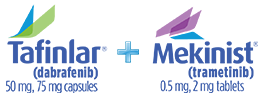
Efficacy
Study Design
The efficacy and safety of TAFINLAR + MEKINIST in pediatric patients aged 1 to <18 years with BRAF V600E mutation–positive low-grade glioma (LGG) were evaluated in the multicenter, open-label, phase 2 clinical trial G2201.1,2,4,*
Patients in the G2201 study had progressive disease following surgical resection, or had not received surgery and needed to begin systemic treatment because of risk of neurological impairment5
BRAF mutation status was identified prospectively via a local assessment or a central laboratory test1,2
*The efficacy and safety of TAFINLAR + MEKINIST have not been established in pediatric patients <1 year old with BRAF V600E+ LGG.1,2
CBR, clinical benefit rate; DOR, duration of response; LGG, low-grade glioma; MEK, mitogen-activated extracellular signal-regulated kinase; ORR, overall response rate; OS, overall survival; PD, progressive disease; PFS, progression-free survival; PROs, patient-reported outcomes; RANO, Response Assessment in Neuro-Oncology; TTR, time to response.
aIndependent review based on RANO LGG (2017) criteria. The primary analysis was performed when all patients had completed at least 32 weeks of therapy. Final analysis included the full study period, including the treatment follow-up period, at last patient last visit (April 2023).1,2,4
bPatients received age- and weight-based dosing of TAFINLAR and MEKINIST until loss of clinical benefit or until unacceptable toxicity.1,2
cVincristine and carboplatin were dosed based on body surface area at doses 1.5 mg/m2 and 175 mg/m2 (0.05 mg/kg for patients <12 kg), respectively, as one 10-week induction course followed by eight 6-week cycles of maintenance therapy.1,2
dPatients with centrally confirmed RANO-defined disease progression will be allowed to cross over to the TAFINLAR + MEKINIST arm.5
Key eligibility criteria5:
Aged 1 to <18 years
Histologically confirmed BRAF V600+ LGG
Locally determined and centrally confirmed measurable disease
No prior BRAF- or MEK-inhibitor treatment, systemic therapy, or radiotherapy
Karnofsky/Lansky performance status ≥50%
MEK, mitogen-activated extracellular signal-regulated kinase.
Response Rates
>4x improvement in overall response rate vs chemotherapy (vincristine and carboplatin)1,2
In the primary analysis, overall response rate was 47% in the TAFINLAR + MEKINIST group (95% CI, 35%-59%; n=73) vs 11% in the chemotherapy group (95% CI, 3%-25%; n=37); P<.001.1,2,†
With TAFINLAR + MEKINIST, complete response (CR) and partial response (PR) were 3% (n=2) and 44% (n=32), respectively, vs 3% (n=1) and 8% (n=3) with chemotherapy1,2
†The P value is computed from χ2 test (Mantel-Haenszel) at a 1-sided 2.5% level of significance.5
Overall response rate (primary end point): Final analysis4,6,a
ORR, overall response rate.
aORR is defined as complete response + partial response.
bOdds ratio (TAFINLAR + MEKINIST vs chemotherapy) and 95% CI are from a logistic regression with treatment as the only covariate. Odds ratio >1 favors TAFINLAR + MEKINIST.6
TAFINLAR + MEKINIST: CR and PR were 3% (n=2) and 52% (n=38), respectively6
Chemotherapy: CR and PR were 3% (n=1) and 14% (n=5), respectively6
Clinical benefit rate (secondary end point): Final analysis6,a
CBR, clinical benefit rate; CR, complete response; PR, partial response; RANO, Response Assessment in Neuro-Oncology; SD, stable disease.
aCBR is the proportion of patients with a best overall response of CR or PR, or an overall lesion response of stable disease that lasts for a minimum of 24 weeks, as assessed by central independent reviewer per RANO criteria.4
TAFINLAR + MEKINIST: CR, PR, and stable disease (SD)‡ were 3% (n=2), 52% (n=38), and 33% (n=24), respectively.6
Chemotherapy: CR, PR, and SD were 3% (n=1), 14% (n=5), and 32% (n=12), respectively.6
In the primary analysis, clinical benefit rate for TAFINLAR + MEKINIST was 86% (95% CI, 76%-93%; n=63) vs 46% for chemotherapy (95% CI, 30%-63%; n=17); P<.0017,§
TAFINLAR + MEKINIST: CR, PR, and SD were 3% (n=2), 44% (n=32), and 41% (n=30), respectively1,2,7
Chemotherapy: CR, PR, and SD were 3% (n=1), 8% (n=3), and 41% (n=15), respectively1,2,7
‡SD is not a component of overall response rate and can reflect the natural progression of disease rather than a direct therapeutic effect.
§The P value is computed from χ2 test (Mantel-Haenszel) at a 1-sided 2.5% level of significance.7
Duration of response (secondary end point): Final analysis4,a
No clinical or statistical conclusions can be drawn.
DOR, duration of response; NE, not estimable.
aTime to response evaluated using descriptive statistics based on independent review among patients with confirmed complete and partial response.4
In the primary analysis, response was seen as early as ~6 weeks with TAFINLAR + MEKINIST (median time to response: 3.6 months; range 1.5-13.0)7,a
Among patients who responded, response sustained over time with median duration of response of 23.7 months (range 14.5-not estimable [NE])1,2
Progression-Free Survival
64% reduction in risk of progression or death with TAFINLAR + MEKINIST vs chemotherapy6
HR, hazard ratio; PFS, progression-free survival.
In the primary analysis, the median progression-free survival was 20.1 months in the TAFINLAR + MEKINIST group (95% CI, 12.8-NE) vs 7.4 months in the chemotherapy group (95% CI, 3.6-11.8); (hazard ratio, 0.31; 95% CI, 0.17-0.55; P<.001)1,2
At 6 months, the Kaplan-Meier estimated event-free rates were 87% (95% CI, 77%-93%) in the TAFINLAR + MEKINIST group vs 55% (95% CI, 36%-70%) in the chemotherapy group6
At 1 year, the Kaplan-Meier estimated event-free rates were 68% (95% CI, 56%-77%) in the TAFINLAR + MEKINIST group vs 27% (95% CI, 13%-44%) in the chemotherapy group6
At 2 years, the Kaplan-Meier estimated event-free rates were 52% (95% CI, 40%-63%) in the TAFINLAR + MEKINIST group vs 21% (95% CI, 8%-36%) in the chemotherapy group6
Results at 6, 12, and 24 months were not prespecified and are observational in nature. As such, there was no prespecified statistical procedure controlling for Type 1 error. No clinical conclusions can be made






